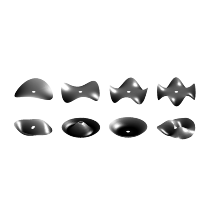Description
The aim of this project is the development of improved and integrated measurement and control strategies for high performance operation of adaptive secondary mirrors in astronomical adaptive optics. Especially, the temporal and spatial response behavior of monolithic deformable mirrors shall be improved by model-based approaches. Thereby, we focus on optimizing sensor and control design based on system inherent properties (e.g. sensor transer functions, plate deformations of the mirror, structural eigenmodes, ...).
Currently, numerous earth based optical telescopes are or will be equipped with deformable seconary mirrors. For example, the Multi Mirror Telescope (MMT), the Large Binocular Telescope (LBT), the Very Large Telescope (VLT), the Giant Magellan Telescope (GMT), and the European Extremely Large Telescope (E-ELT). As state of the art, adaptive secondary mirrors are controlled based on local position feedback for all actuators. Thereby, each actuator is driven by a dedicated local controller. The main advantage of this concept is that the number of actuators can be scaled without affecting the control complexity. However, arising problems of local control are the existing modedependent stiffness variation of the mirror shell and interacting actuators that can lead to high frequency vibrations or even instability of the shell.
In this project, a model-based feedforward control concept for faster settling times and less overshoot for setpoint changes of large deformable mirrors has been already developed. It takes into account local position control loops of excited actuators and mode-dependent stiffness variations of the mirror shell. Based on partial differential equations for the temporal and spatial dynamics of the deformable mirror, a modal approximation of the spatial mirror dynamics was performed.
Our research is focused on four main topics including
- Mathematical modeling of deformable mirrors via partial differential equations
- Simulation of deformable mirrors with high spatial and temporal resolution
- Optimization of sensor and control concepts for deformable mirrors
- Optical simulation of adaptive optics systems including sensor and actuator dynamics
-
Validation of the designed Algorithms in lab experiments
Partner
The optical design of optimized wavefront sensors and the optical simulation of adaptive optics systems is performed in close collaboration with the Institute for Technical Optics.
Publications
- , “Feedforward Control of Deformable Membrane Mirrors for Adaptive Optics”, IEEE Transactions on Control Systems Technology, 21, pp. 579-589, 2013, doi:10.1109/TCST.2012.2186813
- , “Model-based feedforward control of large deformable mirrors”, European Journal of Control, 3, pp. 261-272, 2011, doi:10.3166/ejc.17.261-272
- , “Optimal sensor placement for modal based estimation of deformable mirror shape”, IEEE Conference on Control Applications (CCA), Sydney, Australia, 2015, pp. 418-423, doi:10.1109/CCA.2015.7320665
- , “Actuator placement for minimum force modal control of continuous faceplate deformable mirrors”, IEEE Conference on Control Applications (CCA), Yokohama, Japan, 2010, pp. 867-872, doi:10.1109/CCA.2010.5611311
- , “Modal Trajectory Generation for Adaptive Secondary Mirrors in Astronomical Adpative Optics”, IEEE Conference on Automation Science and Engineering, Scottsdale, USA, 2007, pp. 430-435, doi:10.1109/COASE.2007.4341799
Contact

Michael Böhm
Dr.-Ing.External Lecturer



